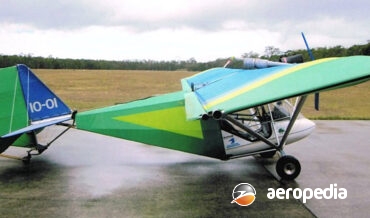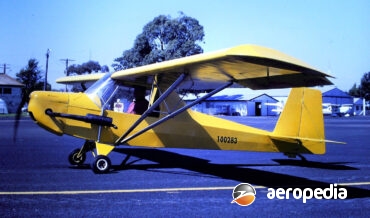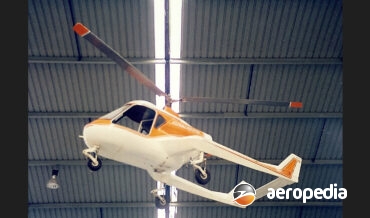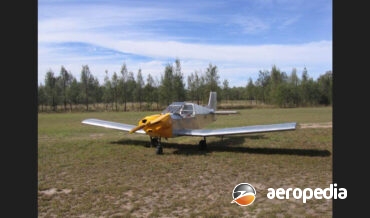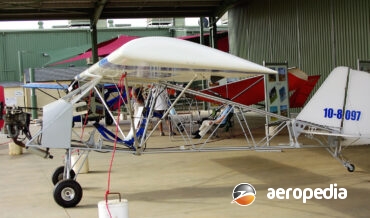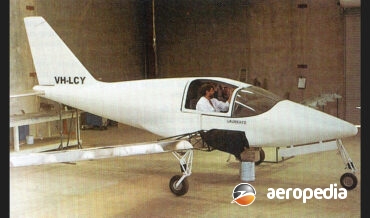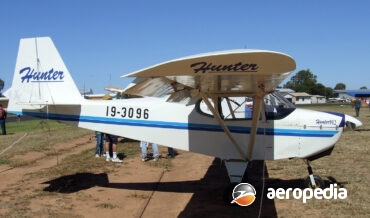David C. Eyre
This aircraft was designed and built by the late Joseph Kostecv and it was powered by a 21-kw (28-hp) Konig four-cylinder radial engine.
David C. Eyre
- May 25, 2020
This was a further light aircraft designed and built by the late Joseph Kostecv, this being a 75% scale Piper J-2 powered by a Konig engine.
David C. Eyre
- May 25, 2020
This aircraft was a homebuilt light aircraft built in a terrace house at Redfern in Sydney before World War II. A press report in the Daily Telegraph from April 1910 described it as the “First Australian-Built Aeroplane”.
David C. Eyre
- May 25, 2020
Following the announcement of Henry Kremer in the United Kingdom inviting interested parties to design and build an aircraft to make the first successful flight of a man powered aircraft.
David C. Eyre
- May 25, 2020
The Kermit was a single-seat ultra-light aircraft designed and built in Australia and made its first flight in 1999. It was fitted with a Rotax 503 engine driving a Sweetapple two-blade propeller.
David C. Eyre
- May 25, 2020
Peter Jones of Tauranga, NZ in 2011 – 12 built a single-seat low-wing monoplane said to be based on a 1950s design from India known as the Monsoon.
David C. Eyre
- May 25, 2020
Mr Jones was the lecturer in charge at the East Sydney Technical College when classes were held in the 1930s in relation to aircraft design and construction and he himself was involved in the design and construction of a number of aircraft of his own design, and with the assistance
David C. Eyre
- May 25, 2020
Early in the 20th century Mr A W Jones went to England and obtained his pilot’s licence. On his return in 1913 he imported a Caudron G.II fitted with a 26-kw (35-hp) to 30-kw (40-hp) Anzani engine.
David C. Eyre
- May 25, 2020
This was an ultra-light aircraft which was registered with the RAA as 10-1477 and was registered from 22 September 1995 until 16 January 1999 when it was retired.
David C. Eyre
- May 25, 2020
Little is known about this ultralight aircraft but one is known to have been involved in an accident near Yeppoon Qld on 6 April 1985.
David C. Eyre
- May 25, 2020
The Joey was probably one of the first powered gliders in Australasia, and was designed and built in Australia by Keith Jarvis of South Australia and placed in production.
David C. Eyre
- May 25, 2020
In May 2003 Mr Lance Watson gave evidence to the Australian House of Representatives Transport and Regional Services Committee of a proposal by his Company to develop an aircraft able to serve remote communities at ‘bus fare prices’.
David C. Eyre
- May 25, 2020
The Hummingbird is a high-performance gyrocopter designed and built in Brazil at Joinville, which is between Florianopolis and Curitaba on the south Brazilian coastline.
David C. Eyre
- May 25, 2020
The TH1 is a single-seat light aircraft built at Leom, New Zealand, in the 1980s. It was one of the first indigenous-designed light aircraft to be completed in New Zealand and is said to be based on the design of the North American P-51 Mustang.
David C. Eyre
- May 25, 2020
This aircraft was noted at an air-show at Aero Pelican, Belmont, NSW in September 1964. The machine was unfinished and was said to have been submitted to the Army Inventions Commission in 1943.
David C. Eyre
- May 25, 2020
Very little is known about this aircraft. It was first registered with Recreation Aviation Australia on 4 December 2008 but nothing further is known about it.
David C. Eyre
- May 25, 2020
Little is known about this aircraft. It is a scaled down Piper J-3 Cub designed and built by the owner and is a single-seater and is painted overall yellow and is powered by a Rotax 277 engine.
David C. Eyre
- May 25, 2020
In July 1988 it was announced a Swedish inventor of the World’s first cardboard aircraft “which is also radar-proof and fire-resistant”, was setting up business in Australia.
David C. Eyre
- May 25, 2020
This was a one-off single-seat parasol wing aircraft painted light blue with dark blue trim which became 10-1887 (c/n 1) under RAA regulations.
David C. Eyre
- May 25, 2020
Mr A McMullen of Fremantle, WA built an aircraft named The Boomerang of his own design. On 12 January 1911 Joseph Hammond examined the machine and said it showed great promise, that it will maintain its poise or equilibrium automatically.
David C. Eyre
- May 25, 2020
Very little is known about this machine other than it was a single-seat gyrocopter of fibreglass construction with a three blade rotor and fitted with a tricycle undercarriage and twin booms carrying the tail.
David C. Eyre
- May 25, 2020
Mr Mac McKenzie is a gyrocopter enthusiast on the north island of New Zealand and in about 2007 commenced the construction of a 70 percent replica of the Cierva C.30 gyrocopter, examples of the original full-scale machine being flown in a number of countries around the world in the 1930s,
David C. Eyre
- May 25, 2020
Mr McKenzie, a New Zealander, designed and partially built a biplane along the lines of an early French Breguet, the latter having been placed on display at the Olympia Aero Show in London In March 1909.
David C. Eyre
- May 25, 2020
The Mayfly 3 was designed by Mr William Watley who had previously built in the 1940s a Mignet HM 290, which made two flights, and a Jodel D-9 which operated from Gatton in Queensland for some years.
David C. Eyre
- May 25, 2020
This was a light homebuilt aircraft designed and built by Sydney Gordon Gooding DFC. Mr Gooding was born at Clare, SA on 21 September 1915 and learned to fly at AFTS Narrandera on DH-82s.
David C. Eyre
- May 25, 2020
Little is known about this machine. The machine was designed and built in South Australia and comprised a metal fuselage and the framework of a cycle mounted thereon and a pylon above the cycle seat and a drive to the two-blade helicopter rotor and the two-blade tail rotor.
David C. Eyre
- May 25, 2020
The Maggie was a single-seat light sporting monoplane of all metal. It was a three axis machine and when completed by its builder / designer, an RAAF fitter, it was fitted with a Volkswagen Pobjoy cam engine with a twin Wegner ignition system.
David C. Eyre
- May 25, 2020
The Voodoo is an Australian designed two-seat light touring monoplane powered by a 119-kw (160-hp) Lycoming O-320 engine and with an empty weight of 494 kg (1,090 lb).
David C. Eyre
- May 25, 2020
M-Squared was founded in 1996 by Paul Mather to design and produce parts of existing ultralight aircraft.
David C. Eyre
- May 25, 2020
Mr John Lowther in New Zealand designed and built a 75% scale replica of a Sopwith F.1 Camel, this being the second aircraft he had designed himself and the ninth light aircraft he had built.
David C. Eyre
- May 25, 2020
Mr C Lindsay-Campbell designed and built an aircraft described as an aero-marine monoplane.
David C. Eyre
- May 25, 2020
The PB-5 is a single-seat high wing ultralight aircraft fitted with a tractor engine and built of steel tube with fabric covering.
David C. Eyre
- May 25, 2020
A Mr Lewis built a monoplane at Diggers Rest, Vic in 1910 and it was fitted with a JAP engine.
David C. Eyre
- May 25, 2020
The LA-122 Preceptor is an Australian designed two-seat twin-engine training monoplane designed by the Laureate Aircraft Company.
David C. Eyre
- May 25, 2020
The Hobbit was an ultra-light designed and built in Australia for the local market and was powered by a 16.4 kw (22-hp) Skylark engine.
David C. Eyre
- May 25, 2020
The Hunter is a two-seat ultra-light aircraft available in kit form and powered by a Rotax 912UL four-cylinder four-stroke liquid-and-air-cooled engine.
David C. Eyre
- May 25, 2020
This was a small ultralight aircraft designed by Robert Labahan and at least one example was registered, this becoming 10-1138 on 16 October 1989 and was fitted with a Rotax 503 engine.
David C. Eyre
- May 25, 2020
Little is known about this aircraft other than it was designed and built by A G Kuhle. It seems to have been a one-off light aircraft powered by a Continental O-200 engine which was registered with the RAA as 28-3133 (c/n V.110).
David C. Eyre
- May 25, 2020
Mr Terrence Kronke was well known in aviation circles as the designer and builder of scale replicas of World War II aircraft, amongst his aircraft being a Supermarine Spitfire with a five-litre Chevrolet V-8 engine.
David C. Eyre
- May 25, 2020
Reginald Ouston, a New Zealander, came to Australia when quite young and in about 1930 commenced construction of a light aircraft of his own design with a Le Rhone engine, this being a two seater.
David C. Eyre
- May 25, 2020
Recent Comments
Archives
Categories
- No categories
Categories
- No categories
Latest Posts
Newsletter


